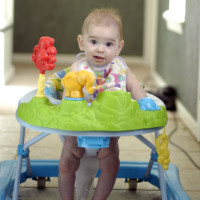Written by Ashiya Hassan, DPT, PCS, Mecklenburg County CDSA
As providers of early intervention services, parents often ask our opinion on the use of various types of positioning equipment for their child. Sometimes the parent initiates the conversation, and other times the provider may find an opportunity to share suggestions. Here is a discussion about three of the most common pieces of positioning equipment that we encounter while engaging with families in their homes.
Scenario 1: The Bumbo Seat
Jaden is 4 months old, and his mother asks, “We just started putting Jaden in the Bumbo seat, and he seems to sit up nicely in it. Do you think the Bumbo is good to use?” How do you respond?
Scenario 2: The Bouncy Seat
8-month-old twins have been referred to early intervention due to gross motor concerns (not sitting or rolling). As you enter the home for the eligibility evaluation, both twins are reclined comfortably in their bouncy seats, and you notice that the back of each child’s head is flat. How do you open conversations with the family now or during the IFSP development meeting?
Scenario 3: The Baby Walker
Beth is 7 months old, and she is in a baby walker when you arrive at the home. She is standing on her tiptoes, her feet not quite able to reach the floor. The family is excited to show you the new walker they just purchased. What do you say?
______________________________________________________________________________________________________________
In your communications with families, take care to guard against sounding judgmental or bossy. Having a discussion with the family to share information and professional recommendations can be important, but recognize that this is a piece of equipment in which the family has already put an emotional and financial investment. Try to avoid doom and gloom statements (ex. The walker is not good for Beth’s development.), and opt for a gentler statement (ex. Sometimes the walker can encourage a baby to stand and walk on her tiptoes.). Below is additional information that may be helpful as you work to support families enrolled in early intervention with positioning options for their child.
______________________________________________________________________________________________________________
The Bumbo Seat
Pros: The Bumbo allows for an upright experience for a baby at a younger age. The parents are happy to see their baby sitting, looking around, and engaging with them in this position as well. The Bumbo seat can allow for an infant to develop head control when they are sitting up.
Cons: The Bumbo seat has been linked to a number of skull fractures in young babies, caused by the placement of the Bumbo seat on a table or sofa (versus having the Bumbo on the floor). In young babies who lack head and trunk control, the Bumbo seat can tip over, causing injury. There are also postural concerns due to the rounded seat, which places the baby’s pelvis in a posterior tilt position (i.e. slouching). When a child slouches, they are not using their abdominal and back muscles to sit upright. Persistent slouching can lead to core muscle weakness.
Suggestion: Using a high chair with towel-roll support as needed is a better developmental positioning option. A family could also use a booster seat with a tray for use on the floor or strapped securely to a chair.
The Bouncy Seat
Pros: Bouncy seats are another positioning option commonly used by families as an alternative to holding or carrying the baby around. They allow more upright interaction, as opposed to having the baby lie on his back. Often times, bouncy seats have hanging toys attached, which can encourage reaching.
Cons: A bouncy seat is a passive positioning device because it requires minimal muscle activation. If a baby spends much of his time in a bouncy seat, his muscles don’t have as many opportunities to strengthen, compared to lying on his back, lying on his stomach, or sitting with support. Too much time in the bouncy seat replaces spending time in these other positions that can help with developing core muscle stability. Also, it often contributes to plagiocephaly or brachycephaly (the side or back of the head being flat). Recent information also suggests that bouncy seats may contribute to increased reflux occurrence, as opposed to upright sitting or tummy time.
The Baby Walker
Pros: Parents usually feel positive about walkers for the following reasons: they believe that walkers help a baby learn to walk, the child is happy and quiet, the walker gives the baby exercise, and often, the walker is used for positioning during mealtimes.
Cons: In the American Academy of Pediatrics (AAP) journal article, Injuries Associated With Infant Walkers, it is recommended that the manufacturing and sale of baby walkers should be banned due to safety concerns and because they been found to have no developmental benefit. More specifically, walkers can even delay typical motor and cognitive development. Also referenced in this article was a 1986 research finding that 12-40% of babies who used walkers had reported injuries resulting in an emergency room visit. The majority of injuries from baby walker use occurred from falls down stairs, resulting in head injury. A small number of injuries occurred from pinched fingers against door thresholds. Burn injuries can also occur if a child reaches up and pulls a hot object down onto themselves.
_____________________________________________________________________________________________________________
It’s important to be aware and respectful of parental choices. Helping parents explore how they can give their babies a variety of positioning options throughout the day is a great idea. While it’s good to give information from a developmental perspective, always affirm the family’s choice without making them feel guilty. Using your own judgment, you may or may not offer an opinion or recommendation on the use of baby equipment, based on the family’s priorities and concerns.






Recently had a conversation about this during an IFSP development with a family. Perfect timing, and thanks for sharing!!